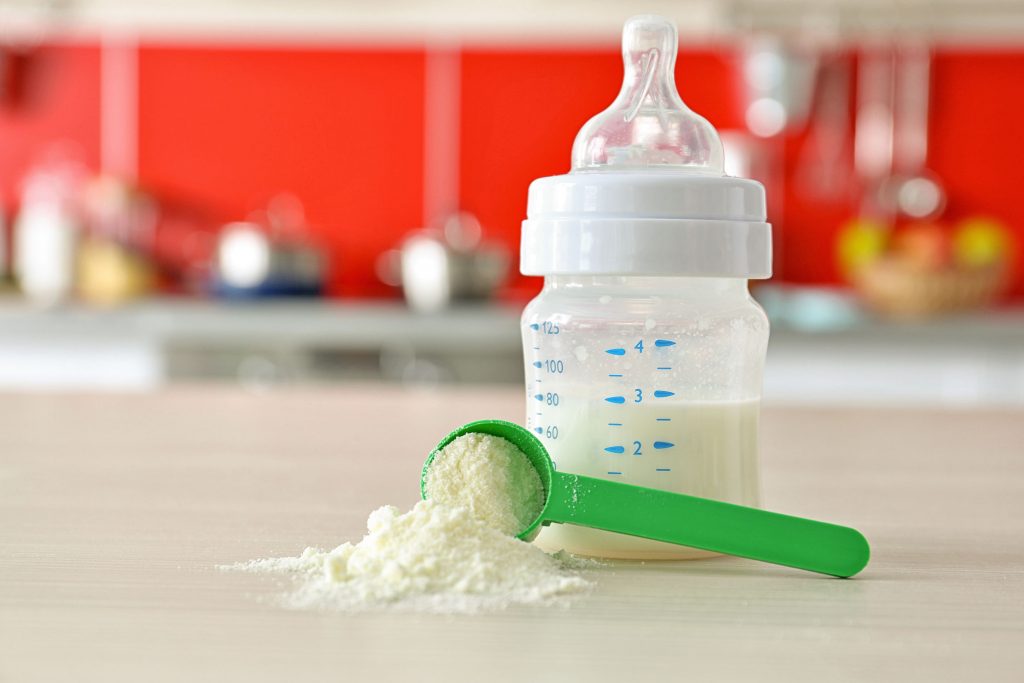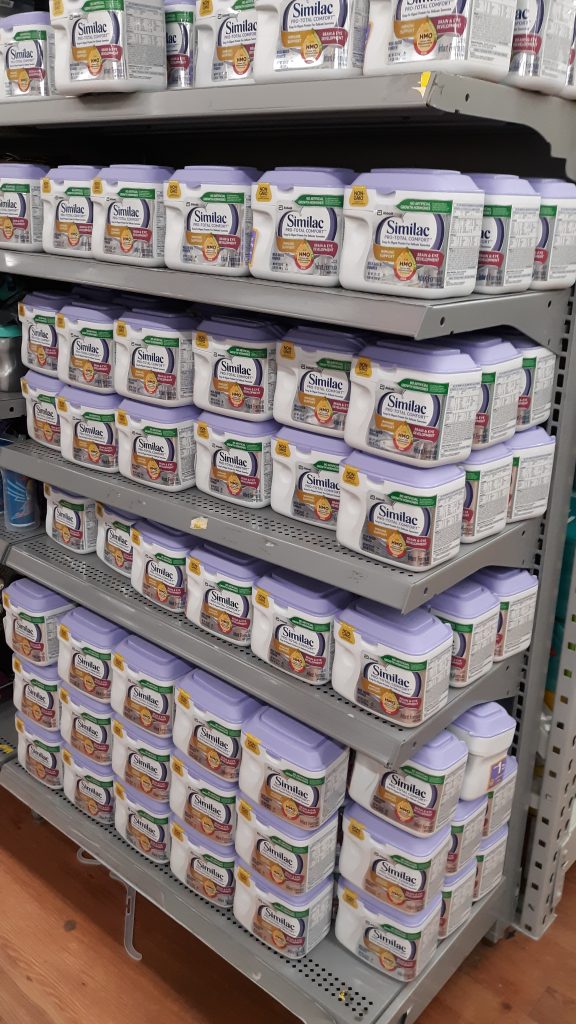One of the most fundamental aspects of caring for a baby is feeding. Unfortunately, it’s also one of the topics that can bring new mothers undue stress. There is tons of research, studies and opinions (so many opinions!) about breastfeeding vs. formula feeding. Ultimately you need to decide what works best for you and your family. But chances are, even if you are committed to breastfeeding, you’ll probably need formula at some point.
Choosing a formula can be difficult. Of course, you want to feed your child the very best. But (news flash), there is no universal “very best.” What works best for one mom-baby duo may not work as well for another. The more you know about formula, the easier it will be to find the “very best” for you and your baby.

How long has baby formula been around?
Baby formula has been available to new mothers since the late 1800s. Although the popularity of formula feeding has risen and fallen over the years, one thing has steadily risen since then: the quality of baby formula. Today’s baby formulas closely mirror breast milk. They are healthy, convenient and delicious.
What’s the difference between all the brands and varieties of formulas?
First, don’t let the sheer number of brands and varieties of baby formula overwhelm you! Instead, remember that with so many different formulas to choose from, there is definitely one you and your baby will love. Even better news? No matter what you choose, your baby will get all the nutrients he or she needs.

While all formulas sold today are nutritious, not all formulas are the same. Here are the most common different types:
Milk based formulas
These formulas are made from cows’ milk that is changed and enhanced to be more like breast milk. Proteins in this milk are altered to make it easy for babies to digest. Fat (usually vegetable oil) is also added to give the milk a similar texture to breast milk. Often milk based formulas are also fortified with iron to help with growth and development.
Soy based formulas
Soy based formulas are made from soybeans and supplemented with vitamins and nutrients. (Again, look for one fortified with iron.) They are usually recommended for babies with a cow’s milk allergy. Soy based formulas differ quite a bit from human milk, so pediatricians usually only recommend these types of formula in rare circumstances.
Organic formulas
These formulas are usually made from cow’s milk that is free from hormones, antibiotics, pesticides or other toxic chemicals. One thing to look out for is the sugar content in some organic formulas. They are sometimes sweetened with sucrose which can lead to tooth decay and weight gain. Check the label.
Hydrolyzed formulas
These formulas are generally best for babies with allergies. Known as “predigested” formula, the proteins are broken down making it easier for babies to digest. Consult your pediatrician before using or switching to this type of formula.
Special formulas
For babies with special needs —either because of allergies, illness or developmental issues —there are some specialty formulas your pediatrician might recommend. These formulas are generally hypoallergenic, lactose free, and soy free. Some may contain probiotics which can help improve gut health.
How do I know which kind of baby formula to choose?
Consult your pediatrician
Always talk to your pediatrician about which formula you should try. If you’ve had a standard pregnancy and birth, and your baby is healthy, most mothers will start with a milk-based formula. If you have special concerns, your pediatrician will be able to offer guidance you can trust.
Listen to your baby,
It would be great if your baby could tell you exactly how he or she is feeling and what he or she likes. Until then, you have to look and listen for all the non-verbal clues your baby gives you. The best places to find these clues is in their diapers, in their cries, and on your burp cloth.
All babies will spit up but if you feel like your baby spits up excessively, or is constantly cranky after feedings, it may be due to the formula. Your baby’s poop can also indicate how well he or she is tolerating the formula. Healthy formula fed baby poop will be like the consistency of peanut butter and shades of yellow or brown. If you notice changes or inconsistencies, consult your pediatrician.
Don’t make assumptions
While a higher price tag can sometimes mean better quality, with baby formula that’s not always the case. Similarly, choosing name brand formulas doesn’t necessarily mean it’s any better. Instead, compare ingredients and see if your pediatrician recommends a certain brand (and don’t be afraid to ask why!). Also talk to your own friends to see what they’ve tried, what they liked, and what they didn’t like. Just remember, your baby is unique and may tolerate formula differently.
Powder or liquid
Baby formulas come in either a powder or liquid form. You’ll need to add water to both of these types of formulas. The liquid form is concentrated so the water helps to dilute the formula. If you opt for powder formulas, you’ll need to measure out both the powder and water and shake to dissolve. Powder formula lasts the longest so it may be more economical.
There is also a ready to use formula that requires no measuring or adding water. These formulas can be expensive though.
Don’t switch too soon
It can be tempting to assume that your child is fussy or not sleeping or spitting up (again!) because of the formula. This may be the reason, but it could also be any number of different issues. Resist the urge to change formulas too quickly. It can take time for little bodies to adjust to new formulas. As long as your baby is peeing and pooping regularly and gaining weight properly, don’t switch formulas before talking with your pediatrician.
How much baby formula will I need?

The amount of formula your baby will drink depends on his or her birth size, growth spurts, and appetite. As a general rule, your baby should take 2.5 ounces for every pound of body weight.
Most newborns will feed every 2 to 3 hours. As they grow, feeding will generally stretch to 3 to 4 hours. Once you introduce solid food (usually around 6 months), they will generally take a bottle every 4 to 5 hours.
Baby Formula Cost Per Month
Of course there are a wide range of baby formulas available and they come with a wide range of costs. You’ll first have to figure out how much your preferred brand costs per ounce. Cheaper brands are about 10 cents per ounce and higher-end organic brands can be well over $1 per ounce. Then you’ll need to multiply the unit cost by about 25 ounces per day (ballpark amount for how much babies need during their first year).
Myths and Realities
Do I really need to warm the bottle?
No! Warming bottles was considered more like breast milk and thought to help the baby digest the milk more easily. The reality is, some babies do prefer their milk warmed, some like it room temperature and some will even drink it cold.
Babies will get used to having their formula at a certain temperature so if you don’t want to have to warm a bottle every time, try starting with room temperature formula.
Should I add rice to my baby’s bottle?
No! Years ago, some parents believed that adding a little rice cereal to formula will help “fill up” the baby. This would help with weight gain and sleep patterns. While this logic seems hopeful, the reality is, not only will your baby not sleep longer but it can also be dangerous. Rice cereal can be a choking hazard and aspirations risk. It’s also unnecessary. Baby formulas are specifically developed with the right amount of calories and nutrients.
